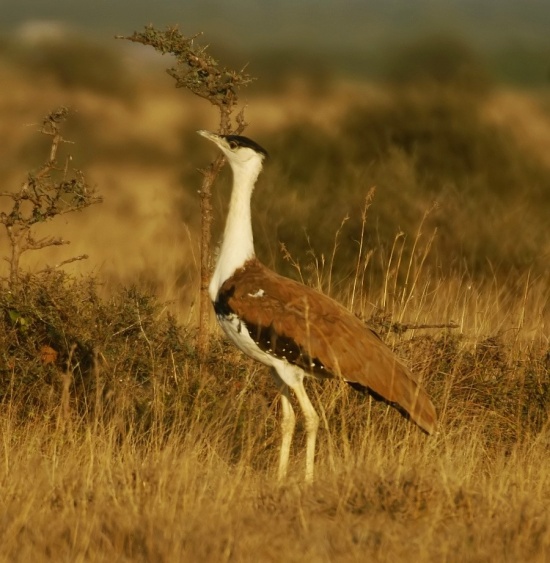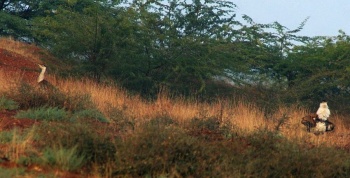Alternative name: Indian Bustard
- Ardeotis nigriceps
Identification
100-122 cm (male), 76-92 cm (female). A huge bird, unmistakable in its range.
- Brown upperparts
- Whitish or grey head and neck
- Black crown with short crest
- Often with indistinct but broad black breastband
- Black wing patch with narrow white bars
- Non-breeding has finely vermiculated grey neck and less voluminous plumes on breast
Females are much smaller, have a white supercilium below black crown, are greyer, have a more distinctly barred neck without plumes and rarely show a breastband.
Immatures are similar to females, but have buff spots on crown, upper back and hindneck, no breastband and a more heavily barred neck and breast.
Similar species
Very similar to Australian Bustard, but ranges don't overlap.
Distribution
Patchily found in northwestern and central India.
A critically endangered species. Extinct in Pakistan and has been extirpated from more than 90% of its former range. Now confined to small patches of grassland, mostly in nature reserves. Population estimated at less than 300 birds, mainly in Rajasthan. Threatened by rapid habitat loss and hunting.
Taxonomy
This is a monotypic species.
Forms a superspecies with Australian Bustard and has been considered conspecific with the latter and Kori Bustard.
Habitat
Arid and semi-arid grasslands.
Behaviour
Like Kori Bustard this species sits down to drink, unlike other bustards.
Diet
An opportunistic feeder. Takes grain, shoots, berries, locusts, grasshoppers, beetles, centipedes, lizards, small snakes and mammals.
Forms small feeding flocks in winter, sometimes associating with antelopes.
Breeding
Breeding throughout the year, varying with area and rainfall. Displaying male inflates white-feathered gular pouch, folds tail over back and struts about with drooped wings and head held high, calling periodically.
The nest is a shallow scrape, often with no cover. Lays 1 egg, sometimes 2.
Movements
A sedentary or seasonally nomadic species.
References
- Clements, J. F., T. S. Schulenberg, M. J. Iliff, B.L. Sullivan, C. L. Wood, and D. Roberson. 2013. The eBird/Clements checklist of birds of the world: Version 6.8., with updates to August 2013. Downloaded from http://www.birds.cornell.edu/clementschecklist/download/
- Del Hoyo, J, A Elliot, and J Sargatal, eds. 1996. Handbook of the Birds of the World. Volume 3: Hoatzin to Auks. Barcelona: Lynx Edicions. ISBN 978-8487334207
Recommended Citation
- BirdForum Opus contributors. (2025) Great Indian Bustard. In: BirdForum, the forum for wild birds and birding. Retrieved 25 April 2025 from https://www.birdforum.net/opus/Great_Indian_Bustard
External Links
GSearch checked for 2020 platform.






